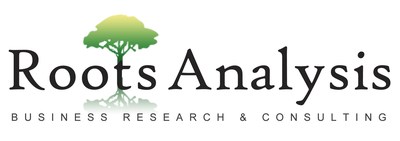With Over USD 4 Billion in Capital Investment, the Synthetic Lethality-based Drugs Market is Poised to Witness a Rapid Growth, Claims Roots Analysis
The synthetic lethality approach enables the development of targeted therapies that are inherently able to select between normal and transformed cells. With four approved drugs, namely olaparib, rucaparib, talazoparib and niraparib, the synthetic lethality-based drugs pipeline has evolved significantly over the past few years. Moreover, certain pipeline candidates have already entered mid to late-stage (phase II and above) trials and are anticipated to enter the market over the next 5-10 years.
To order this 485+ page report, which features 195+ figures and 200+ tables, please visit this link
Key Market Insights
Over 70+ candidate drugs under development, mostly being evaluated by start-ups / small companies
Nearly 25% of the pipeline drugs have entered the clinical phase, while 70% are in the preclinical / discovery stage. The research work is primarily being driven by smaller companies / start-ups; more than 60% of the companies were established after 2010.
90% of pipeline drugs are small molecules and are being developed to treat advanced oncological indications
Indications with more than eight drugs in different stages of development include advanced solid tumors, breast cancer, and ovarian cancer. Drugs are also being evaluated for the treatment of non-oncological indications, such as chronic liver disease, diabetic macular edema, idiopathic pulmonary fibrosis, mitochondrial disease, neurodegeneration disorder, Parkinson's disease, and renal fibrosis.
2,100+ tweets posted related to synthetic lethality, since 2010
The total number of tweets have considerably increased (CAGR 39%), indicating the growing public interest in this domain. Further, PARP and BRCA emerged as prominent synlet targets, while prostate cancer and leukemia were observed to be the most frequently talked about disease indications that are being discussed on Twitter.
Close to 750 grants awarded for research on synthetic lethality, since 2014
The number of grants awarded in the US alone, have increased at a CAGR of 60%, between 2014 and 2018. Close to 40% of the total amount awarded was under the R01 mechanism (which is related to the conduct of research projects). The NCI, NICHD, NIEHS and NIGMS emerged as key organizations, having offered for support periods of more than 20 years.
Over USD 4 billion invested by both private and public investors
Around USD 1.5 billion was raised through venture capital, representing around 35% of the total capital raised by industry players in the last several years. Since 2010, there have been seven IPOs, accounting for more than USD 900 million in financing of synthetic lethality related initiatives.
Significant advances in research has led to the discovery of 230+ synlet targets
Such targets are presently validated across different stages of research. Specifically, 40+ targets are already clinically / preclinically validated, while over 160 targets have been mentioned in various research publications. Interestingly, a significant number of such targets are being under investigated by big pharmaceutical companies.

40+ companion diagnostic tests available against various synlet targets
More than 40% of the overall companion diagnostic tests are available / being developed for drugs targeting HER and BRCA1/2 gene mutations. Further, majority of the companion diagnostics have been developed for the detection of breast cancer.
North America and Europe are anticipated to capture over 70% market share by 2030
With a promising development pipeline and encouraging clinical results, the market is anticipated to witness a rapid growth rate during the next decade. In addition to North America and Europe, the markets in China and Japan are also anticipated to grow at a relatively faster rate.
To request a sample copy / brochure of this report, please visit this link
Key Questions Answered
The USD 6.5 billion (by 2030) financial opportunity within the synthetic lethality market has been analyzed across the following segments:
The report features inputs from eminent industry stakeholders, according to whom synthetic lethality-based drugs are currently considered to be promising alternatives for the treatment of a myriad of oncological indications. The report includes detailed transcripts of discussions held with the following experts:
The research covers brief profiles of several companies (including those listed below); each profile features an overview of the company, financial information (if available), synthetic lethality-based drug portfolio and current development status.
For additional details, please visit
https://www.rootsanalysis.com/reports/view_document/synthetic-lethality-based-drugs-and-targets-market-2019-2030-focus-on-dna-repair-including-parp-inhibitors-and-other-novel-cellular-pathways/267.html or email [email protected]
You may also be interested in the following titles:
Contact:
Gaurav Chaudhary
+1(415)800-3415
[email protected]
Logo: https://mma.prnewswire.com/media/742223/Roots_Analysis_Logo.jpg





